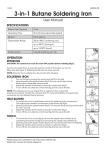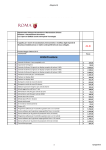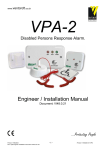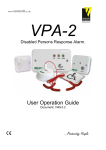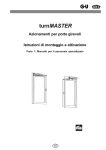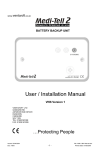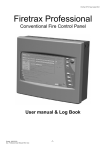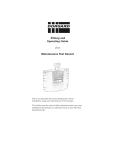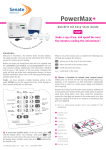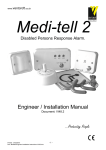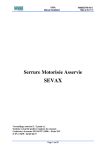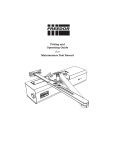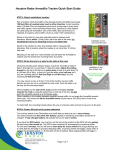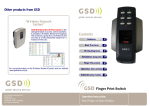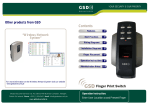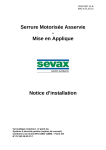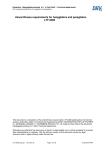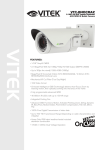Download Door Release Power Supply
Transcript
www.Protectingpeople.co.uk Door Release Power Supply Engineer / Installation Manual Document: VI55.1 …Protecting People Printed : 04/03/2004 Doc : Door Release Installation Instructions V55.1.doc -1- Door Release Power Supply Instillation Instructions VI55.1 Ventcroft Ltd Door Release Power Supply Engineer / Installation Manual First Printed: 10.12.03 Document :VI55.1 Revision: Rev 01 Last Revised : 22.12.03 Copyright © 2003 by Ventrcroft Ltd. All rights reserved. No part of this manual may be reproduced or transmitted in any form or by any means, electronic or mechanical, including photocopying, recording, or by any information storage or retrieval system, without prior written permission from the publisher. Notice of Liability Every effort has been made to ensure that this manual / instructions contains accurate and current information. However, Ventcroft Ltd shall not be liable for any loss or damage suffered by the readers as a result of information held herein. Trademarks. Ventcroft and the Ventcroft logo / device are trademarks and Ventcroft Ltd All other trademarks are acknowledged as trademarks of their respective companies. Printed: 04/03/2004 Doc : Door Release Installation Instructions V55.1.doc –2– Door Release Power Supply Instillation Instructions VI55.1 Engineer / Installation Manual Table of Contents 1.0 Description........................................................................................................................................ 4 2.1 Features – Standard (VPS-24TRA300S) ......................................................................................... 4 2.2 Features – Premium – (VPS-24TRA300P)....................................................................................... 5 3.0 Kit Contents ...................................................................................................................................... 5 4.0 Technical Description ...................................................................................................................... 6 4.1 Terminal Descriptions - Door Release Power Supply (VPS-24TRA300S/P)......................................................................6 4.2 Jumper Settings .................................................................................................................................................................6 4.3 PSU Internal Safety Fuses.................................................................................................................................................7 4.3.1 F1 – 24V Supply – 500mA, Anti Surge / Timed. .............................................................................................................7 4.3.2 F2 – Mains Transformer Internal Fuse, 0.63A, 120 Deg (Non Replaceable). .................................................................7 4.3 Front Mounted LED Description.........................................................................................................................................8 4.3.1 LED Display Types Quick Look Up Guide. .....................................................................................................................8 4.3.2 Green LED – Power........................................................................................................................................................8 4.3.3 Amber LED – Fault .........................................................................................................................................................8 4.3.4 Red LED – Activation......................................................................................................................................................9 4.4 Front Mounted Key-Switch (Premium models only) ...........................................................................................................9 4.4.1 Latching facility .............................................................................................................................................................10 4.5 Internal Piezo Buzzer (Premium models only) .................................................................................................................10 5. Installation......................................................................................................................................... 11 5.1 General Installation Considerations. ................................................................................................................................11 5.3 Mounting and Fixing.........................................................................................................................................................12 5.3.1 PSU ..............................................................................................................................................................................12 5.4 Wiring and Termination....................................................................................................................................................12 5.4.1 Relay Contacts..............................................................................................................................................................12 5.4.2 Mains Terminal .............................................................................................................................................................13 5.4.3 Fire I/P ..........................................................................................................................................................................13 5.4.4 Manual Release ............................................................................................................................................................13 6.0 Commissioning............................................................................................................................... 14 6.1 Powering Up ....................................................................................................................................................................14 6.2 Testing .............................................................................................................................................................................14 7.0 Operation and Functionality.......................................................................................................... 14 7.1 Normal Quiescent. (ACTIVE)...........................................................................................................................................14 7.2 Release (RELEASE)........................................................................................................................................................14 7.2.1 Fire Input Release.........................................................................................................................................................14 7.2.2 Manual Release ............................................................................................................................................................15 7.2.3 Key-Switch Release (premium models only) ................................................................................................................15 7.3 Mute A Fault. ...................................................................................................................................................................15 8.0 Maintenance and Regular Testing ................................................................................................ 15 8.1 Regular System Testing...................................................................................................................................................15 9.0 Specifications ................................................................................................................................. 16 9.1 Door Release Power Supply - Standard ..........................................................................................................................16 9.2 Door Release Power Supply - Premier ............................................................................................................................17 9.3 Door Release Power Supply KIT .....................................................................................................................................18 Notes: .................................................................................................................................................... 19 Printed: 04/03/2004 Doc : Door Release Installation Instructions V55.1.doc –3– Door Release Power Supply Instillation Instructions VI55.1 1.0 Description Ventcroft’s range of door retainer power supplies offers two models. The premium model is a feature rich, simple to install and operate door retainer power supply with key-switch operation. The Standard model offers fewer features but retains the simplicity of use and ease of instillation. The Fire trigger input requires 16-30V @ only 0.5mA to release the doors. The Manual Trigger input requires any resistance of less then 47KΩ to be applied across its contacts to release the doors, this makes it ideal for use with call points and any other equipment with voltage free contacts. There is no need for any external fire panel monitoring to be used as the PSU actively monitors the Fire trigger input to check if Fire Panel is still present (selectable). The Power supply is controlled by a microprocessor which provides excellent stability and allows the PSU to be used with a wide range of devices. The PSU also contains an external watchdog, in the unlikely event of a microprocessor fault or failure the external watchdog will automatically signal a fault and close all doors. 2.1 Features – Standard (VPS-24TRA300S) • Simple Instillation and Maintenance. • 24V Output (unregulated). • Built in Heavy Duty Relay. • Capable of driving 10 x 24V 30mA Door Retainers, total of 300mA • Microprocessor Controlled. • Complete with Surface Mounting Double Gang Back box. • External Watchdog. • 24V O/P Fuse Monitoring. • 3 Front Mounted Status LED's (Power, Fault & Release). • Over-Load Protection. • Fault Enable/Disable Option. • System Integrity Fire Panel Monitoring. • Manual Release Terminal. Printed: 04/03/2004 Doc : Door Release Installation Instructions V55.1.doc –4– Door Release Power Supply Instillation Instructions VI55.1 2.2 Features – Premium – (VPS-24TRA300P) • Simple Instillation, Maintenance and Fault Diagnosis. • 24V Output (unregulated). • Built in Heavy Duty Relay. • Capable of driving 10 x 24V 30mA Door Retainers. • Microprocessor Controlled. • Complete with Surface Mounting Double Gang Back box. • External Watchdog • 24V O/P Fuse Monitoring. • 3 Front Mounted Status LED's (Power, Fault & Release). • Over-Load Protection. • Fault Enable/Disable Option. • System Integrity Fire Panel Monitoring. • Manual Release Terminal. • On Board Buzzer. • Class Change Enable/Disable Option. • Fault Mute Option. • Front Mounted - Release / Mute / Latch Key-switch. 3.0 Kit Contents VDR-KIT, Door Retainer Kit Sold Complete With a mini Door Release Power Supply (VPS-24TRA300S) Standard Model, 24 Vdc un-regulated supply, built in heavy duty relay triggerable with three methods, and three status LED’s and a Surface mount 24Vdc Door Retainer (VDR-S24) ; 24 Vdc +/- 15%, 30 mA, 0.6W, 83x83x46, 20daN Holding Force,0-40 Deg C,IP54 Contents 1 * Door Retainer Power Supply (VPS-24TRA300S) 1 * Surface Mount Door Retainer (VDR-S24) 1 * Deep Base Double Gang Surface Back Box. 1 * Engineer / Installation Manual 1 * User Manual 1 * Accessory Bag Containing: 2 * keys (Premium models only) 1 * Spare 500 mA Fuse Printed: 04/03/2004 Doc : Door Release Installation Instructions V55.1.doc –5– Fig.1 Door Release Power Supply Instillation Instructions VI55.1 4.0 Technical Description This section provides brief technical information about the functionality and setup of the Door retainer power supply. 4.1 Terminal Descriptions - Door Release Power Supply (VPS-24TRA300S/P) Mains L N Relay 24V OUT Key SW-SW Manual Fire I/P Release E + _ The Mains terminals are how the PSU receives its main power source. L terminal connects to the Live mains wire, N connects to the Neutral mains wire and E is used to connect to the mains earth wire. It is good practise to fit a Non switched fused spare, fitted with a 1A fuses between the PSU and the mains supply. Any wiring or termination to mains supply should be in accordance to IEE and, or regulations and carried out by a trained and qualified electrician. The Fire I/P Terminals are used to connect the PSU to the fire panel. These Terminals should be connected to a suitable O/P on the Fire Panel. When these terminals receive a voltage between 16V and 32V the PSU will close all the doors that are connected to it. ● The Manual Release Terminal can also be used to close the doors, This terminal is constantly monitored, to activate the release a resistance of less than 47kΩ should be applied across these terminals. ● ● The Switch terminals are used to connect the front mounted Key Switch (where available) and should not used to connect to any other device. + _ These Terminals Provide the 24V Unregulated Output. 300mA MAX ● This Connection is Common. C NC This Connection is Normally Closed. NO This Connection is Normally Open. 4.2 Jumper Settings Standard Models are fitted with the Fault Enable Pins only. Premium Models are fitted with two sets of selection pins these are:Selection Class Change On Off Class Change Enabled - 16 second delay Class Change Disabled - No delay Fault On Off Fault Monitoring Enabled – Fire I/P Fault Monitoring Disabled – Fire I/P All Models have overload protection and 24V O/P fuse monitoring. The Fault Enable option is used to select fault reporting for the FIRE I/P. Printed: 04/03/2004 Doc : Door Release Installation Instructions V55.1.doc –6– Door Release Power Supply Instillation Instructions VI55.1 Fig.2 4.3 PSU Internal Safety Fuses The PSU has 2 internal safety fuses to protect the sensitive electronics from external current overloads and short circuits, the internal transformer fuse is to conform to regulation and limit any risk of fire. 4.3.1 F1 – 24V Supply – 500mA, Anti Surge / Timed. The 24V Supply Fuse protects the PSU circuitry, and any other device that are connected to it. 4.3.2 F2 – Mains Transformer Internal Fuse, 0.63A, 120 Deg (Non Replaceable). The Mains Transformer Internal Fuse protects the PSU from overheating. The chance of this fuse blowing or breaking is very rare and highly unlikely and is circuit protection is mandatory and is nonreplaceable. Printed: 04/03/2004 Doc : Door Release Installation Instructions V55.1.doc –7– Door Release Power Supply Instillation Instructions VI55.1 4.3 Front Mounted LED Description The PSU has 3 front mounted status LED’s to provide user feed back. The LED’s enable engineer and user to distinguish and recognise all status conditions of the PSU and system. A Green LED shows the state of the power supply, a Red LED displays the status of activations and an Amber LED shows any Fault conditions. The LED’s can operate in a number of ways to show the PSU’s status. The LED’s can be constantly illuminated and they can also flash in a number of ways. Fig.3 4.3.1 LED Display Types Quick Look Up Guide. LED Description Display Constantly Illuminated Flashing Once Per Seconds on and Off. (1Hz) Slow Blink Once Every 5 Seconds (0.2 Hz) Increasing Flash, the Flash rate increases with time. (0.5Hz to 3Hz) Not Illuminated Off. 4.3.2 Green LED – Power The Green provides feedback of the state of the Mains power supply. Not illuminated Constantly illuminated. Flashing once per second. 1Hz No Power Present to the device Power Supply ok Power Supply overload. Too much current being drawn from the device 4.3.3 Amber LED – Fault The Amber Fault Led is indicates faults present on the system. Action Not illuminated Constantly illuminated. Flashing once per second. 1Hz Description No Fault General Fault Fuse Blown or missing – 24V Supply not available Printed: 04/03/2004 Doc : Door Release Installation Instructions V55.1.doc –8– Door Release Power Supply Instillation Instructions VI55.1 4.3.4 Red LED – Activation The red activation LED provides the user with information about the type of activation. Action Description Not illuminated No Activation Flashing 1 Hz, Once per second Manual Release Latched or Power Supply overload. Too much current being drawn from the device (all LED’s Flashing) Increasing Flash Class Change in progress – 16 Second Delay Constantly Illuminated Doors Being Released 4.4 Front Mounted Key-Switch (Premium models only) The front mounted Key-Switch can be used for a variety of tasks. These Include:State Action Quiescent Activate system and release doors Fault Mute Class Change Override Class change and release doors. Latching The Key-switch can be turned twice to enable the latch facility. See below. Activate system and release doors To Release the doors at any time insert the key and turn clockwise to the release / mute position, all LED’s will illuminate and the buzzer (Premium models only) will sound for approx 2 seconds and the door(s) will be released. Turn the key back to its ACTIVE position. The door retainers are now active, if the doors are opened they will be held open. If you require the doors to be latched closed (remain closed indefinitely) see 4.4.1 Latching facility section below. Alternately the key can be turned to the release position and left in this position. This however is not recommended as the keys can be removed by unauthorised persons. Mute To mute a fault condition simply insert the key and turn the key clockwise to the release / mute position, the fault will still be displayed but will only generate a small beep every 10 seconds. Class change When class change is enabled the doors will not close immediately in the event of the sounders being activated, during this time the PSU will be pulsing the RED (release) LED and sounding the buzzer (Premium models only), this will happen for approx 15 seconds before the doors are closed, during this time the key can be turned to the release / mute position and override the class change and release the doors immediately. Printed: 04/03/2004 Doc : Door Release Installation Instructions V55.1.doc –9– Door Release Power Supply Instillation Instructions VI55.1 4.4.1 Latching facility The PSU has the ability to latch the doors closed. This means that the doors can remain closed indefinitely. This is done by turning the key from its active position to the release position, then back to its active position then to the release position and back to its active position. Simplified – turning the key twice. The key can now be removed and the doors will remain closed. To cancel this feature simply insert the key and turn to release and back to active again. Fig.4 4.5 Internal Piezo Buzzer (Premium models only) The Internal Piezo buzzer provides audible feed back to the users and engineers, and enhance the front mounted LED’s. Action Description PSU in quiescent No Sound Fault Constant Tone Class Change Short Pulse Tone, speed increasing with time Muted Short Beep Every 15 Seconds. Activation Constant Tone Printed: 04/03/2004 Doc : Door Release Installation Instructions V55.1.doc – 10 – Door Release Power Supply Instillation Instructions VI55.1 5. Installation This section will cover the Considerations, Planning, installation and testing process, from mounting, wiring to testing of the PSU. 5.1 General Installation Considerations. When planning a Door Release Power Supply, the positioning of all components should be given careful consideration before mounting, for accessibly of the user, accessibility for cabling and the type of surface to be mounted too. Fused Spare Fire Panel Door Release Power Supply Door Retainers Fig.5 For wiring purposes as can be seen in fig.5 the PSU is wired between the Fire Panel and Door Retainers. Each Door Release Power Supply can power a maximum of 300mA approx 10 standard 24V Door Retainers. When mounting the PSU it should be ensured that there is sufficient space for cabling and the fused spare. The fused spare can be mounted in a separate location. The PSU can supply a maximum of 300mA, on average each door retainer will provide a load of between 20mA and 30mA dependant on its type. If too many devices are connected to the PSU (i.e. the current exceeds 300mA), a fault will be displayed. This fault will be displayed as all LED’s flashing and buzzer beeping (Premium models only). During this time the power to the devices will be removed. After 15seconds the power will be re-applied briefly if there are still too many devices attached then the system will remove power and wait another 15 seconds, this will continue until the current is reduced to 300mA or less. Printed: 04/03/2004 Doc : Door Release Installation Instructions V55.1.doc – 11 – Door Release Power Supply Instillation Instructions VI55.1 5.3 Mounting and Fixing. This section deals with the detail of mounting and connection the PSU. 5.3.1 PSU (Double patress) Preferred Mounting Points Preferred Mounting Points Fig.6 The PSU has been designed to fit a double patress and can be fitted flush or surface mount. The PSU is supplied complete with a double patress. 5.4 Wiring and Termination. This sections deals with the wiring and connection of the PSU to the mains supply and other external devices. 5.4.1 Relay Contacts Before making any connections to the PSU make sure that it is isolated from the mains supply. Connect the chain of door release power supplies to the relay contacts. The preferred method is shown below. Door Retainer (+) C NC RELAY NO Door Retainer (-) + - Fig.7 24V OUT Door Retainers are chained together, positive to positive and negative to negative. Up to 10 x 30mA door retainers can be chained together using this PSU. Printed: 04/03/2004 Doc : Door Release Installation Instructions V55.1.doc – 12 – Door Release Power Supply Instillation Instructions VI55.1 5.4.2 Mains Terminal Connect the mains supply wires, observe the correct polarity. Live (Red) to “L”, Neutral (Black) to “N” and Earth to “E”. Note before making any connections ensure the mains supply is off/ / isolated. 5.4.3 Fire I/P Connect the fire panel to the PSU. There are several methods of connecting the fire panel t the PSU, they are listed below. Connecting the PSU to the sounder O/P. The Sounder O/P of the Fire panel is connected to the Fire I/P of the PSU. Simply connect the Positive Terminal of the sounder O/P to the Positive terminal of the Fire I/P and the negative terminal of the sounder O/P to the negative terminal of the Fire I/P. Note : the PSU’s fault monitoring on the FIRE I/P Terminals may not be supported by all makes of fire panel, this feature can be disabled by moving the FAULT selection header to the OFF position. Connecting the PSU to the Fire O/P The Fire O/P of the Fire panel is connected to the Fire I/P of the PSU. Simply connect the Positive Terminal of the Fire O/P to the Positive terminal of the Fire I/P and the negative terminal of the Fire O/P to the negative terminal of the Fire I/P. Note : the PSU’s fault monitoring may not be supported by all makes of fire panel, this feature can be disabled by moving the FAULT selection header to the OFF position. Connecting the PSU to a relay. The Fire I/P is connected to a switched relay contact. The relay should be capable of switching 24V DC to the Fire I/P terminals. 5.4.4 Manual Release The manual release terminals can be connected to almost any voltage free contacts such as call points or relays. The Manual release should be connected as shown below. Manual Release Manual Release Fig.8 Resistance ≤ 47KΩ Printed: 04/03/2004 Doc : Door Release Installation Instructions V55.1.doc – 13 – Door Release Power Supply Instillation Instructions VI55.1 6.0 Commissioning This section sets out to ensure that the Door Release PSU has been completely tested and the User is comfortable with is operation. 6.1 Powering Up Once the system is fully installed, the door retainers wired correctly and the front cover fitted the mains supply can now be applied to the PSU. The Front Mounted LED’s will now flash in sequence RED, YELLOW then GREEN, the buzzer should sound with each LED (Premium models only). Once all the LED’s have been illuminated the RED and YELLOW LED’s should go off, leaving only the GREEN Power LED. The PSU is now in its quiescent mode and is awaiting a trigger signal on one of its inputs. 6.2 Testing The Entire Door Retainer System should now be thoroughly tested. Each Trigger input should be activated in turn and all doors connected to the PSU should close. 7.0 Operation and Functionality This section sets out to detail the operation and functionality of the Door Release PSU and how to “Activate” and “Reset” the System. 7.1 Normal Quiescent. (ACTIVE) Normal Quiescent mode is when the PSU is in standby and waiting to receive a valid trigger from the fire panel or any of its other terminals (if connected). In “Normal Quiescent Mode” the PSU has mains power supplied and only the Green power LED is illuminated. 7.2 Release (RELEASE) “Release” occurs when a valid signal has been received from one or more of the PSU’s input terminals i.e. Fire Panel, Call Point, key-switch, or any other appropriate devices connected. 7.2.1 Fire Input Release A fire input release occurs when the PSU receives a valid signal from the Fire panel at the FIRE INPUT terminals. The microprocessor will take several samples of the data before deciding if it is valid, once the decision is made to release the doors the microprocessor will switch over the relay contact, illuminate the RED (RELEASE) LED and sound the buzzer (Premium models only). This will continue as long as there continues to be a valid signal from the fire panel, once this signal stops the relay is switched back to its original position and the doors can now be held open. If class change is enabled then there will be a delay from the start of the signal from the fire panel to the doors being closed (approx 15sec). If the signal is removed before the delay ends then the doors will not close. E.g. if the bells are sounded for 5 seconds for class change then the doors will not close. Printed: 04/03/2004 Doc : Door Release Installation Instructions V55.1.doc – 14 – Door Release Power Supply Instillation Instructions VI55.1 7.2.2 Manual Release A manual release occurs when the PSU receives a valid signal from the MANUAL RELEASE terminals, the microprocessor constantly monitors these terminals for a resistance of less than 47kΩ if a resistance of less than 47kΩ is measured then the microprocessor will switch over the relay contact, illuminate the RED (RELEASE) LED and sound the buzzer (Premium models only). If the signal form the MANUAL RELEASE contact remains after the doors have been release the RED (RELEASE) LED will continue to flash and the buzzer (Premium models only) sound in sympathy will the LED until the signal is removed. Once the signal is removed the relay is switched back to its original position and the doors can now be held open. 7.2.3 Key-Switch Release (premium models only) A key-switch release occurs when the PSU receives a valid signal from the KEY-SW terminals, the microprocessor constantly monitors these terminals for the actuation of the key-switch. Once an activation has occurred then the microprocessor will switch over the relay contact, illuminate the RED (RELEASE) LED and sound the buzzer (Premium models only). The microprocessor will also be monitoring the KEY-SW terminal for the latched state. See 4.4.1 Latching facility. Once the signal is removed the relay is switched back to its original position and the doors can now be held open 7.3 Mute A Fault. During a fault condition the buzzer(Premium models only) will be sounding continuously, to mute the buzzer simply turn the key-switch clockwise to the RELEASE / MUTE position and back anticlockwise to the ACTIVE position, the buzzer will now be silent and will only produce a small beep every 10 seconds. 8.0 Maintenance and Regular Testing This section details the regular and necessary testing and inspection of the Door Retainer Power Supply. Its is just as important to provide regular testing and maintenance of the system as it is to install the system correctly. 8.1 Regular System Testing. The entire system to be tested regularly to ensure the system is always ready for use. The testing is simple simply activate each input in turn and check that all doors connected to the PSU close. E.g. Turn the key-switch clockwise to the RELEASE position and make sure all doors have closed, turn the key-switch back to the ACTIVE position and open all doors. Trigger the MANUAL RELEASE Terminals (if fitted) and make sure all doors have closed, reset the trigger on the MANUAL RELEASE and open all the doors. Trigger the Fire Panel alarms check that all the doors connected to the PSU have closed, silence/reset the Fire Panel alarms and open all the doors. It is recommended that the whole system be tested a minimum of at least once per month, but it is desirable to fully test or part the system on a weekly basis. Printed: 04/03/2004 Doc : Door Release Installation Instructions V55.1.doc – 15 – Door Release Power Supply Instillation Instructions VI55.1 9.0 Specifications 9.1 Door Release Power Supply - Standard Detailed Specifications Power Supply LED's Mains Input Voltage 230Vac 50Hz Transformer Primary Thermal Fuse Quiescent Standby Current 0.63A 102 DEG C. (Non Replaceable) 15mA dc Maximum Overall Supply Current 300 mA dc (Max.) Front Mains - Green Mounted Release - Red Fault - Yellow Fuses Mains On Constant Total Power Failure Off Doors Released Constant Doors Latched – Manual Release Flashing 1 Hz General Fault Constant Fuse Blown/Missing Flashing 1 Hz F1: 24V Supply Fuse - Monitored 500mA Anti Surge 20mm Glass 630mA 120 Deg (NonReplaceable). F2: Internal Transformer Housing Front Cover European Polycarbonate - Fire Retardant. Polycarbonate - Fire Retardant. CE Ingression Protection Rating. IP20 PSU - Standard VPS-24TRA300S PSU - Premier VPS-24TRA300P KIT VDR-KIT Door Retainer VDR-S24 Period 2 Years from Date of Manufacture Date of Manufacture Marked On PCB 18/12/03 Back Box Compliance Re-Ordering Warranty Identification Last Updated Printed: 04/03/2004 Doc : Door Release Installation Instructions V55.1.doc – 16 – Door Release Power Supply Instillation Instructions VI55.1 9.2 Door Release Power Supply - Premier Detailed Specifications Power Supply User Operation LED's Quiescent Standby Current 230Vac 50Hz 0.63A 102 DEG C. (Non Replaceable) 15mA dc Maximum Overall Supply Current 300 mA dc (Max.) Mains Input Voltage Transformer Primary Thermal Fuse Key-switch Front Mounted Single Turn Clockwise Release Doors – Doors close Single Turn Clockwise Mute Fault – short beep every 15 sec. Double turn Clockwise Latch Doors – Doors remain closed Mains - Green Mains On Constant Mains Fail Off Doors Released Constant Release - Red Door Release Latched – Manual Flashing 1 Hz Release Fault - Yellow Class Change In Progress Flashing – Increasing speed General Constant Fuse Missing Flashing - 1 Hz P Internal Buzzer Type Premium models only Current Peizo, PCB Mounted 5mA max. Frequency Sounds Fuses 1 Khz Tone Doors Released Fault Mute Class Change F1: 24V Supply Fuse - Monitored 500mA Anti Surge 20mm Glass 630mA 120 Deg (NonReplaceable). F2: Internal Transformer Housing Front Cover European Polycarbonate - Fire Retardant. Polycarbonate - Fire Retardant. CE Ingression Protection Rating. IP20 PSU - Standard VPS-24TRA300S PSU - Premier KIT VPS-24TRA300P VDR-KIT Door Retainer VDR-S24 Period 2 Years from Date of Manufacture Date of Manufacture Marked On PCB 18/12/03 Back Box Compliance Re-Ordering Warranty Constant Constant Beep Every 10 Seconds Beep - Increasing speed Identification Last Updated Printed: 04/03/2004 Doc : Door Release Installation Instructions V55.1.doc – 17 – Door Release Power Supply Instillation Instructions VI55.1 9.3 Door Release Power Supply KIT Detailed Specifications Power Supply Door Retainer PSU LED's Quiescent Standby Current 230Vac 50Hz 0.63A 102 DEG C. (Non Replaceable) 15mA dc Maximum Overall Supply Current 300 mA dc (Max.) Holding Force 20daN Voltage 24 Nominal Power 0.6Watt Release Button Yes Mains Input Voltage Transformer Primary Thermal Fuse Front Mounted Mains - Green Release PSU Internal Buzzer Type Premium models only Current Frequency Sounds PSU Fuses - Red Mains On Constant Mains Fail Off Doors Released Constant Door Release Latched – Manual Flashing 1 Hz Release Peizo, PCB Mounted 5mA max. 1 Khz Tone Doors Released Fault Mute Class Change F1: 24V Supply Fuse 500mA Anti Surge 20mm Glass 630mA 120 Deg (NonReplaceable). F2: Internal Transformer Housing PSU Compliance Re-Ordering Warranty Constant Constant Beep Every 10 Seconds Beep - Increasing speed Polycarbonate - Fire Retardant. Door Retainer PSU Front Cover Back Box Box European Door Retainer Ingression Protection Rating. Conformity IP20 EN1155, BS5839 Ingression Protection Rating IP52 Grey Ral 9002 Painted Steel CE PSU - Standard VPS-24TRA300S PSU - Premier VPS-24TRA300P KIT Door Retainer VDR-KIT VDR-S24 Period 2 Years from of Manufacture Identification Date of Manufacture Marked On PCB 18/12/03 Last Updated Printed: 04/03/2004 Doc : Door Release Installation Instructions V55.1.doc – 18 – Door Release Power Supply Instillation Instructions VI55.1 Notes: Printed: 04/03/2004 Doc : Door Release Installation Instructions V55.1.doc – 19 – Door Release Power Supply Instillation Instructions VI55.1 Technical Help If you have any difficulties with this product please call our technical help line. Tel. 01928581098 Fax. 01928581099 ALL INFORMATION IS GIVEN IN GOOD FAITH BUT WITHOUT WARRANTY. IN THE INTEREST OF CONTINUAL PRODUCT DEVELOPMENT VENTCROFT LTD, RESERVE THE RIGHT TO MODIFY PRODUCTS WITH OUT PRIOR NOTICE. VENTCROFT AND THE VENTCROFT DEVICE ARE ALL TRADEMARKS OF VENTCROFT LTD VENTCROFT 2002 © Printed: 04/03/2004 Doc : Door Release Installation Instructions V55.1.doc – 20 – E&OE




















